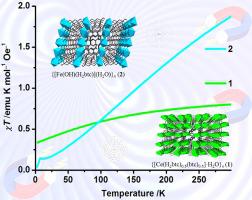当前位置:
X-MOL 学术
›
Inorg. Chem. Commun.
›
论文详情
Our official English website, www.x-mol.net, welcomes your
feedback! (Note: you will need to create a separate account there.)
Magnetic Behaviour of 3D Metal−Organic Frameworks Constructed via 1,2,4,5-Benzenetetracarboxylate Linker and 4f Ce(III) or 3d Fe(III) Metal Nodes
Inorganic Chemistry Communications ( IF 4.4 ) Pub Date : 2020-12-01 , DOI: 10.1016/j.inoche.2020.108261 Muhammad Usman , Maximillian Chibuike , Deepak Patil , Sergei Rigin , Songwei Zhang , Yiying Wu , Jennifer Lindline , Tatiana V. Timofeeva
Inorganic Chemistry Communications ( IF 4.4 ) Pub Date : 2020-12-01 , DOI: 10.1016/j.inoche.2020.108261 Muhammad Usman , Maximillian Chibuike , Deepak Patil , Sergei Rigin , Songwei Zhang , Yiying Wu , Jennifer Lindline , Tatiana V. Timofeeva

|
Abstract Herein, a pair of 3D MOFs were constructed by the solvothermal reactions of the 1,2,4,5-benzenetetracarboxylic acid (H4btc) with Ce(NO3)3·6H2O or FeCl2·4H2O. Single-crystal X-ray diffraction analysis revealed that the Ce-based MOF {[Ce(H2btc)0.5(btc)0.5]·H2O}n (1) crystallized in a triclinic system (PĪ) to form a 3D network due to two different coordination modes of btc− with Ce(III). While, Fe-based MOF (2) adopted a 3D crystal structure within a monoclinic space group (C2/c), consuming only one type of btc− coordination. Thermogravimetric analyses showed that both compounds 1 and 2 were highly stable up to ~ 300 °C after removal of water molecules. Temperature dependent magnetic study indicated paramagnetic behaviour for compound 1, while compound 2 exhibited weak antiferromagnetic couplings; these differencing behaviour for compound 1 and 2 were driven by their respective 4f rare earths and 3d transition metal ions. This study on magnetic transitions in different metals based MOFs will pave the way to further investigate the role of metal ions and their concentrations in controlling the magnetic orderings in MOFs.
中文翻译:

通过 1,2,4,5-苯四羧酸盐接头和 4f Ce(III) 或 3d Fe(III) 金属节点构建的 3D 金属-有机框架的磁行为
摘要 在此,通过 1,2,4,5-苯四甲酸 (H4btc) 与 Ce(NO3)3·6H2O 或 FeCl2·4H2O 的溶剂热反应构建了一对 3D MOF。单晶 X 射线衍射分析表明,Ce 基 MOF {[Ce(H2btc)0.5(btc)0.5]·H2O}n (1) 在三斜晶系 (PĪ) 中结晶形成 3D 网络,这是由于两个btc− 与 Ce(III) 的不同配位模式。而铁基 MOF (2) 在单斜空间群 (C2/c) 内采用 3D 晶体结构,仅消耗一种类型的 btc− 配位。热重分析表明,去除水分子后,化合物 1 和 2 在高达 ~ 300 °C 的温度下都高度稳定。温度相关磁性研究表明化合物 1 具有顺磁行为,而化合物 2 表现出弱的反铁磁耦合;化合物 1 和 2 的这些差异行为是由它们各自的 4f 稀土和 3d 过渡金属离子驱动的。这项关于不同金属基 MOF 中磁跃迁的研究将为进一步研究金属离子及其浓度在控制 MOF 中磁序中的作用铺平道路。
更新日期:2020-12-01
中文翻译:

通过 1,2,4,5-苯四羧酸盐接头和 4f Ce(III) 或 3d Fe(III) 金属节点构建的 3D 金属-有机框架的磁行为
摘要 在此,通过 1,2,4,5-苯四甲酸 (H4btc) 与 Ce(NO3)3·6H2O 或 FeCl2·4H2O 的溶剂热反应构建了一对 3D MOF。单晶 X 射线衍射分析表明,Ce 基 MOF {[Ce(H2btc)0.5(btc)0.5]·H2O}n (1) 在三斜晶系 (PĪ) 中结晶形成 3D 网络,这是由于两个btc− 与 Ce(III) 的不同配位模式。而铁基 MOF (2) 在单斜空间群 (C2/c) 内采用 3D 晶体结构,仅消耗一种类型的 btc− 配位。热重分析表明,去除水分子后,化合物 1 和 2 在高达 ~ 300 °C 的温度下都高度稳定。温度相关磁性研究表明化合物 1 具有顺磁行为,而化合物 2 表现出弱的反铁磁耦合;化合物 1 和 2 的这些差异行为是由它们各自的 4f 稀土和 3d 过渡金属离子驱动的。这项关于不同金属基 MOF 中磁跃迁的研究将为进一步研究金属离子及其浓度在控制 MOF 中磁序中的作用铺平道路。































 京公网安备 11010802027423号
京公网安备 11010802027423号